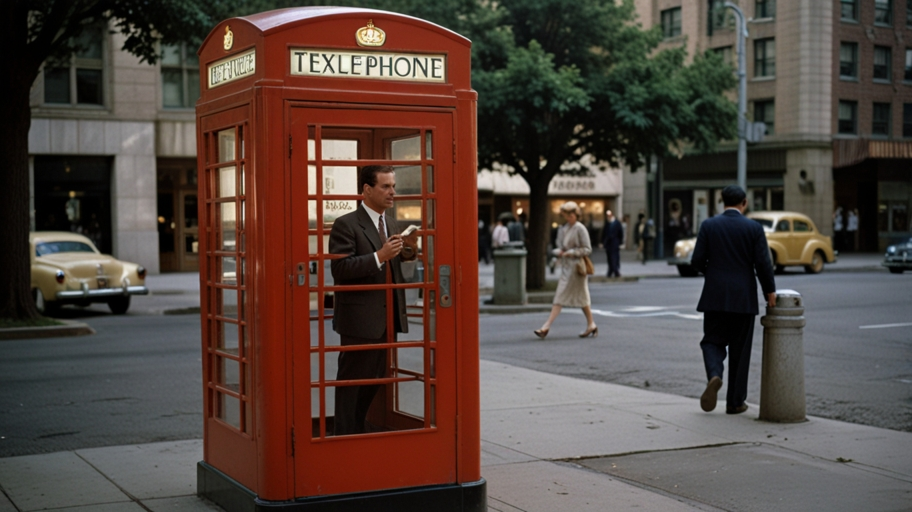Introduction:
The 1939s Outdoor Phone Booth in US represents a nostalgic chapter in the evolution of communication technology. These graceful designs, which could have been seen on street corners, parks, and other public places, were much more than call booths. This article delves into the design, cultural significance, and enduring legacy of the 1939s Outdoor Phone Booth in US, showcasing its impact on society and its role in shaping modern communication.
The Beginning of Unsheltered Telephone Kiosks in US:
Public telephone structures, or kiosks, as the phone booth was known, began to feature outdoors in the early twentieth century with the increase in the provision of phone services. Due to the requirements for easily accessible, hard-wearing, and weatherproof telephonic communication, outdoor telephone kiosks began to be introduced in the early 1930s. The 1939s outdoor phone booth in US was especially noteworthy due to its unique design features and widespread adoption. These booths were designed and built to be practical and pretty and reflected the urban environment of the period well.
Design and Features of the 1939s Outdoor Phone Booth in US:
The design of the 1939s Outdoor Phone Booth in US was a remarkable blend of form and function. They were mainly improvised shelters distinguished by transparent glass walls and doors to ensure the users’ confidentiality while being visible for security’s sake. The metal workmanship was strong enough to prevent any damage by weather factors, hence the booths could be used outdoors comfortably.
One major characteristic of the 1939s outdoor phone booth in US was that the Payphone dialing system was applied, allowing dialing only after putting in coins. This innovation was helpful to people to communicate since they did not own personal telephones, which were considered convenient for every household in the period. At the time, the most common type of telephone was associated with rotary dials, and every booth had this type of telephone and a small ledge for placing items while using the phone.
Cultural Significance of the 1939s Outdoor Phone Booth in US:
The outdoor phone booth in the US in 1939 was more than just a utility; it was a cultural icon. These booths were also used for signing greetings with friends, serving as an intermediate zone for those who needed privacy, and providing a link to help in case of an emergency. They were a common feature of the every day, represented in cinema, prose, and commercial media as representations of contacts and the contemporary.
In the context of the 1930s and 1940s, the 1939s Outdoor Phone Booth in US played a crucial role in bridging communication gaps. At this time, America was experiencing the Great Depression and preparing for the up-and-coming war, World War II. They were essential as they enabled people to communicate with their families and friends, conduct pro forma and other commercial transactions, and occasionally gain the information they needed to manage their lives more effectively.
The Decline of the 1939s Outdoor Phone Booth in US:
While the outdoor phone booth in the US in 1939 was a revolutionary innovation, its prominence began to wane in the latter half of the 20th century. After the introduction of personal telephones, they were gradually replaced by movable phones, known today as mobile phones. This led to the phasing out of phone booths. Phone booths were removed from many areas when advanced technologies requiring signals and networks were introduced.
The History and Conservation of the 1939s Outdoor Phone Booth in the United States:
Despite their decline, efforts have been made to preserve the legacy of the 1939s Outdoor Phone Booth in US. Certain sorts have installed new functionalities on old telephonic kiosks, turning them into art pieces or even libraries to provide Wi-Fi. These colorful adaptations ensure Americans have not forgotten the 1939 outdoor phone booth still in use today.
Recently, people have returned to the concept of retro designs, making the 1939s outdoor phone booth in US an essential sign of nostalgia. People and fanatics of the booths went to them looking for tremendous collectibles and valuable memorabilia, their design, and history. This is why Americans today have taken the initiative to preserve phone booths as historical landmarks, as do most museums and historical societies in the country.
Modern Reflections on the 1939s Outdoor Phone Booth in US:
The 1939s Outdoor Phone Booth in US offers a fascinating lens through which to examine the evolution of communication technology. It may no longer serve the purpose of actual need, but its role in society can scarcely be measured. The phone booth symbolizes a time when people used a phone consciously and did not use it whenever they felt like it. It is because it makes people distance themselves from each other, but our technology is awful.
Outdoor phone booths in the US in 1939 came as a revelation to the younger generation to show them how things were in the past. It creates interest in the subject and wonders at the creativity of old cultures and the overall progress and concern in and with the ways that have led to contemporary media. We will also progress to the next phase of 1939s outside the telephone booth in the USA, which is still a sign of the advanced technology and need for communication in society.
Conclusion:
The 1939s outdoor phone booth in US symbolizes innovation, resilience, and cultural significance. As a piece of architecture, it is synonymous with American culture, and its construction directly influenced societal relations. Though it no longer stands, its impact remains through continued preservation and recreation and firsthand experiences of those who knew of its existence approximately.
As we look back on the story of the 1939s Outdoor Phone Booth in US, we are reminded of the importance of accessibility, the beauty of simplicity, and the timeless value of human connection. This chapter in relations history is the place and source of inspiration for future developments—to build technologies that reunite individuals with the common goal of carrying out the lessons of previous generations.






